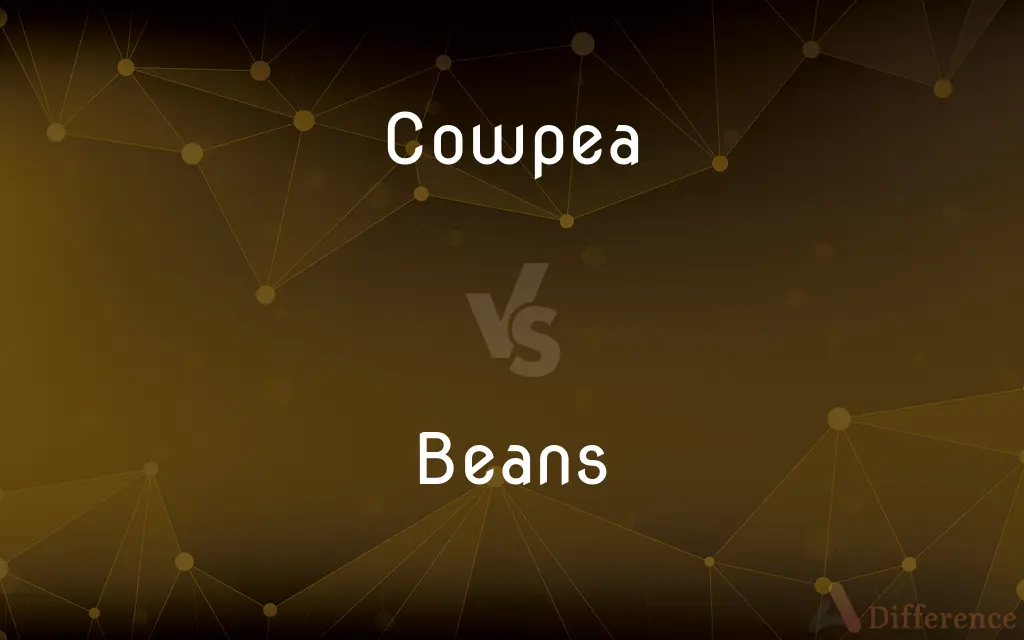Cowpea vs. Beans — What's the Difference?
By Urooj Arif & Fiza Rafique — Updated on March 19, 2024
Cowpea, a type of legume, is known for its tolerance to hot weather and poor soil, while beans refer to a larger family of legumes with diverse climates and soil requirements.

Difference Between Cowpea and Beans
Table of Contents
ADVERTISEMENT
Key Differences
Cowpeas are particularly noted for their drought tolerance and ability to fix nitrogen in the soil, which can improve soil health and reduce the need for chemical fertilizers. This attribute makes cowpeas an excellent crop for sustainable farming practices. Beans, while also capable of nitrogen fixation, vary widely in their tolerance to drought and soil conditions, making some types more dependent on regular irrigation and fertile soils.
In terms of nutritional value, cowpeas are rich in protein, fiber, and essential vitamins and minerals, making them a crucial dietary staple in regions where they are grown. While beans, in general, offer similar nutritional benefits, including high protein and fiber content, the specific nutritional profile can vary significantly among different bean types.
Culinary uses of cowpeas are diverse, ranging from salads and stews to being ground into flour. Their ability to adapt to various recipes makes them a versatile ingredient in many cuisines. Beans, with their wide range of types, offer an even broader culinary versatility, with each type bringing unique flavors and textures to dishes, from the creamy texture of cannellini beans to the firmness of kidney beans.
The cultivation of cowpeas is often associated with traditional farming systems, where they are intercropped with cereals like millet and sorghum, enhancing biodiversity and reducing pest and disease outbreaks. The cultivation of beans is more varied, with some types being grown on a large scale in monocultures, especially in regions where mechanized farming is prevalent, while others are grown in mixed cultures similar to cowpeas.
Comparison Chart
Climate Preference
Hot, dry climates
Varies widely (cool to hot climates)
ADVERTISEMENT
Soil Tolerance
Tolerates poor soil
Varies; some require fertile soil
Nutritional Value
High in protein, fiber, vitamins, and minerals
High in protein and fiber; nutritional content varies by type
Culinary Uses
Salads, stews, flour
Wide range, including soups, salads, and main dishes
Agricultural Practices
Often intercropped, sustainable
Varies; from monocultures to intercropping
Compare with Definitions
Cowpea
Known for drought tolerance and nitrogen-fixing ability.
Cowpeas can improve soil health without the need for chemical fertilizers.
Beans
Some varieties require more water and fertile soil.
Pinto beans need regular irrigation and rich soil for optimal growth.
Cowpea
A vital source of protein and nutrients in many diets.
In some regions, cowpeas are a primary protein source.
Beans
Offers a broad nutritional profile across different types.
Navy beans are high in fiber, while black beans are rich in antioxidants.
Cowpea
Versatile in cooking, used in a variety of dishes.
Cowpeas can be made into stews, salads, or even flour.
Beans
Includes a wide variety of species with diverse climate preferences.
Kidney beans prefer cooler climates, while black beans thrive in warmth.
Cowpea
Thrives in hot, dry climates, making it suitable for challenging environments.
Cowpeas are often grown in parts of Africa where other crops fail.
Beans
Culinary uses vary greatly among types, enhancing many dishes.
Cannellini beans are popular in Italian soups, while kidney beans are staples in chili.
Cowpea
Often grown in sustainable, intercropped systems.
Cowpeas are commonly intercropped with cereals to enhance soil fertility.
Beans
Cultivation practices range from monoculture to mixed cultures.
Some bean types are grown in large-scale monocultures for efficiency.
Cowpea
The cowpea (Vigna unguiculata) is an annual herbaceous legume from the genus Vigna. Due to its tolerance for sandy soil and low rainfall, it is an important crop in the semiarid regions across Africa and Asia.
Beans
Any of various twining herbs of the genus Phaseolus in the pea family, native to the Americas, having leaves with three leaflets and variously colored flowers, and widely cultivated for their edible pods and seeds.
Cowpea
An annual African plant (Vigna unguiculata) in the pea family, widely cultivated in warm regions for food, forage, and soil improvement.
Beans
A seed or pod of any of these plants.
Cowpea
An edible seed of this plant. In both senses also called black-eyed pea.
Beans
Any of several related plants or their seeds or pods, such as the adzuki bean, broad bean, or soybean.
Cowpea
Any of the plants in the species Vigna unguiculata, including the black-eyed pea.
Beans
Any of various other plants or their seeds or fruits, especially those suggestive of beans such as the coffee bean or vanilla bean.
Cowpea
The seed of one or more leguminous plants of the genus Dolichos; also, the plant itself. Many varieties are cultivated in the southern part of the United States.
Beans
(Slang) A person's head.
Cowpea
A leguminous plant (Vigna Sinensis, syn. Vigna Catjang) found throughout the tropics of the Old World. It is extensively cultivated in the Southern United States for fodder, and the seed is used as food for man.
Beans
Beans(Slang) A small amount
I don't know beans about investing.
Cowpea
Fruit or seed of the cowpea plant
Beans
Chiefly British A fellow; a chap.
Cowpea
Sprawling Old World annual cultivated especially in southern United States for food and forage and green manure
Beans
To hit (another) on the head with a thrown object, especially a pitched baseball.
Cowpea
Eaten fresh as shell beans or dried
Beans
Plural of bean
Beans
S; drugs in pill form.
Popping beans
Beans
An insignificant value or amount.
Beans
A cut that reaches the hypodermis.
He told me he reached beans, I hope he’ll be okay.
Common Curiosities
What is a cowpea?
Cowpea is a legume known for its tolerance to hot, dry conditions, commonly grown in Africa and Asia.
What makes cowpeas suitable for poor soils?
Cowpeas can tolerate poor soil conditions and help improve soil health through nitrogen fixation.
Can beans grow in dry conditions like cowpeas?
Some beans can tolerate dry conditions, but their drought tolerance varies widely among species.
What makes beans versatile in cuisine?
The wide range of bean types offers various flavors and textures, making them adaptable to many dishes.
What are beans?
Beans refer to a variety of legume species with diverse environmental preferences and uses.
Are cowpeas and beans nutritionally similar?
Both are high in protein and fiber, but specific nutritional values vary among cowpeas and bean types.
What agricultural practices are associated with cowpeas?
Cowpeas are often intercropped with cereals, promoting sustainable farming.
How do cowpeas and beans differ in climate preference?
Cowpeas prefer hot, dry climates, while beans have a wide range of climate preferences.
Can beans be intercropped like cowpeas?
Yes, some beans are suitable for intercropping, which can enhance soil health and biodiversity.
Do all beans fix nitrogen in the soil?
Yes, all beans, including cowpeas, have the ability to fix nitrogen, though their impact on soil varies.
What is the environmental impact of growing cowpeas vs. beans?
Both can positively impact the environment through nitrogen fixation, though the extent depends on cultivation practices.
How are cowpeas used in cooking?
Cowpeas can be used in salads, stews, and as flour, among other preparations.
How do bean cultivation practices vary?
Practices range from intensive monocultures to sustainable intercropping, depending on the bean type.
Why are cowpeas important in traditional diets?
They are a key protein source in many parts of Africa and Asia where meat is scarce.
Are cowpeas resistant to pests and diseases?
Cowpeas are relatively hardy but can be susceptible to certain pests and diseases.
Share Your Discovery

Previous Comparison
Pious vs. Sanctimonious
Next Comparison
Meridional vs. SeptentrionalAuthor Spotlight
Written by
Urooj ArifUrooj is a skilled content writer at Ask Difference, known for her exceptional ability to simplify complex topics into engaging and informative content. With a passion for research and a flair for clear, concise writing, she consistently delivers articles that resonate with our diverse audience.
Co-written by
Fiza RafiqueFiza Rafique is a skilled content writer at AskDifference.com, where she meticulously refines and enhances written pieces. Drawing from her vast editorial expertise, Fiza ensures clarity, accuracy, and precision in every article. Passionate about language, she continually seeks to elevate the quality of content for readers worldwide.















































